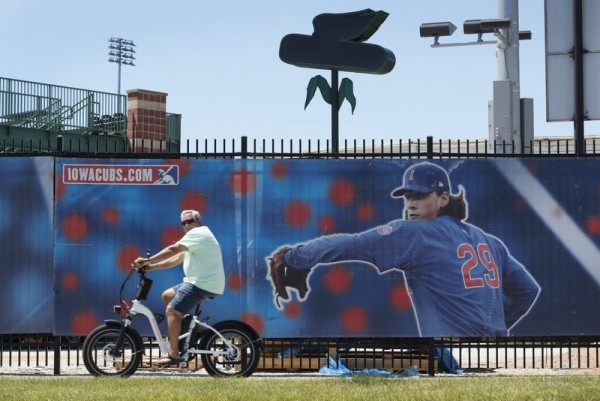(AP) Willie Mays is turning 90, and no mistaking that number. It strikes with the clarity of a line drive. Mays played in a sport measured by milestones — 3,000 hits, 500 homers, signposts he passed and then some — and now here’s one more.
On Thursday, when baseball’s oldest living Hall of Famer is serenaded with renditions of “Happy Birthday to You,” it might be time to expand the playlist. A player of such infinite variety deserves as much.
There’s plenty to choose from. References to the Giants center fielder cut across the years and the genres — rock, pop, folk, country, rap, hip hop.
The two most frequent mentions come in what have become ballpark anthems: John Fogerty’s “Centerfield” and Terry Cashman’s “Talkin’ Baseball (Willie, Mickey & The Duke).”
Fogerty grew up in San Francisco, his father a Joe DiMaggio fan. His song, released in 1985, is one of hope on a day when all seems possible: “We’re born again, there’s new grass on the field/A-roundin’ third, I’m headed for home/It’s a brown-eyed handsome man.” The “brown-eyed handsome man” streaking to the plate is a tribute to the 1956 song of the same name by Chuck Berry but may well be the Say Hey Kid himself.
Fogerty goes on to sing of a player riding the bench and dying to get into the game. He summons a pantheon of outfielders: “So say, ’Hey Willie, tell Ty Cobb and Joe DiMaggio/Don’t say it ain’t so you know the time is now.” Finally, there is the plea and the heart of the song: “So put me in coach, I’m ready to play today/Look at me, I can be centerfield.” Mays, no doubt, would understand.
“Talkin’ Baseball” came out during the major league strike of 1981. It’s anchored around talk — fierce arguments across boroughs and barstools — about whether Mays, Mantle or Snider was the better center fielder in New York during the 1950s. Cashman’s vote is clear: “And me, I always loved Willie Mays/Those were the days!” Mays also gets top billing in the title and when the names of the trio are sung in the refrain. And the song ends this way: “… (Say hey, say hey, say hey).”
Even Snider wasn’t about to argue. In 1979, Mays was only player elected to the Hall of Fame by the baseball writers, with Snider finishing second. Snider said at the time, “Willie more or less really deserves to be in by himself.” The Duke joined Mays in Cooperstown the next year.
Just about everyone saw something in Mays. Maybe it was the dash around the bases, his cap flying. Or the slashing hits to all fields. Or those stickball games with kids in Harlem not far from the old Polo Grounds. Or the gentle tap of his glove before a basket catch and his run back to the infield after an inning, carrying the ball as if it were a wounded bird. Or maybe the sheer joyful lyricism of the name “Willie Mays.”
Those running the playlist on Mays’ birthday have options apart from Fogerty and Cashman.
Certainly, Chuck Prophet’s “Willie Mays is Up at Bat” deserves a listen. The song is from the 2012 “Temple Beautiful” album honoring San Francisco, the city Prophet calls home. It begins as a kind of hymn: “I hear the church bells ring, Willie Mays is up at bat/I hear the crowd go wild, all he did was touch his hat.”
A litany of references to Prophet’s city follows, and not all the lyrics passed the smell test of fact-checkers. Even Prophet acknowledges he didn’t get everything right. Like this line: “And the only thing we know for sure is Willie always did swing for the fence.”
So many ways to brush back that assertion. But Game 7 of the 1962 World Series will do. Giants at bat and trailing the Yankees 1-0 in the ninth. Matty Alou is on first with two out. Mays, hardly swinging for the fence, laces a double into the right field corner. Alou, wary of Roger Maris’ arm in right, screeches to a stop at third. That sets up a wrenching finish for the Giants when Willie McCovey lines out to second baseman Bobby Richardson.
Bob Dylan, raised in the Minnesota town where Maris was born, had a soft spot for baseball. He wrote about pitcher Jim “Catfish” Hunter in the song “Catfish.” Years earlier, in 1963, his “Freewheelin’” album features “I Shall Be Free.” In it, President Kennedy asks a drunk “what we need to make the country grow.” Dylan jumps from one cultural touchstone to another. And right along with bagels, pizza, Sophia Loren and Charles de Gaulle is this line: “What do you do about Willie Mays.”
For Joe Henry, it was tantamount to asking about the soul of the country -- “this frightful and this angry land.” Released in 2007, “Our Song” is a meditation on a lost America that opens in his imagination with Willie Mays and his wife looking to buy garage door springs at a Home Depot in Scottsdale, Arizona. Henry is close enough in the aisle to hear Mays say: “This was my country/This was my song.” Mays, in Henry’s telling, is a mythic figure, “Stooped by the burden of endless dreams/His and yours and mine.”
But let’s raise the volume for this birthday shout-out. Run-DMC will do the job, with its 1993 song “What’s Next.” A couple of bored guys are walking down Broadway in New York with “lots of lovely ladies like a-lookin’ our way.” How to respond? How to summon just the right amount of cool? Easy: “Play like Willie Mays all-star and ‘Say Hey.’”
Wu-Tang Clan did likewise in “For Heaven’s Sake” in 1997. This is someone whose “solar razor burn through shades” and who glides like “hovercrafts on the Everglades.” But when it comes to the arbiter of all that’s hip, Wu-Tang Clan is clear: “Yo, hey yo my rap style swing like Willie Mays.”
But if the birthday honoree wants to recognize a familiar voice there’s “Say Hey (The Willie Mays Song)” by The Treniers. Mays himself was part of the 1955 song, which was included on the soundtrack for the 1994 documentary “Baseball” by Ken Burns:
“He runs the bases like a choo-choo train
Swings around second like an aeroplane
His cap flies off when he passes third
And he heads home like an eagle bird.”
The group The Baseball Project takes listeners on a reverie through the mist of seasons in “Sometimes I Dream of Willie Mays”: a father and son at a Dodgers-Giants game at Candlestick Park to watch Mays face Sandy Koufax; a jump to 1973, with Mays now on the New York Mets and letting a ball go through his legs; and then a return to the Polo Grounds and black-and-white footage of Mays’ overhead catch and spinning throw in the 1954 World Series. “Sometimes I dream of Willie Mays,” the lyric goes, “And the sun comes out, and the fog lifts, and he’s there.”
Yes, he is. So happy birthday, Willie Mays. Blow out the candles and, like an eagle bird, fly home.

















